How Pros Really Make Roasted Cod (And How You Can, Too)
I’ve spent more time in professional kitchens than I can count, from high-energy coastal spots to cozy neighborhood bistros. And through it all, one thing has always rung true: a simple dish, done perfectly, will beat a fancy, complicated one every single time. This roasted cod is the definition of that idea. It’s more than just a recipe; it’s a masterclass in how to make ingredients sing.
In this article
This is the dish I used to teach new cooks. It’s all about respecting the fish and understanding how texture and temperature create something magical. When you nail it, you get incredibly flaky, moist cod, sweet and jammy tomatoes, and a topping that delivers a loud, satisfying crunch with every bite. So, let’s break it down. We’re not just following steps; we’re going to learn the ‘why’ behind each one, so you can move from copying a recipe to truly understanding how to cook.
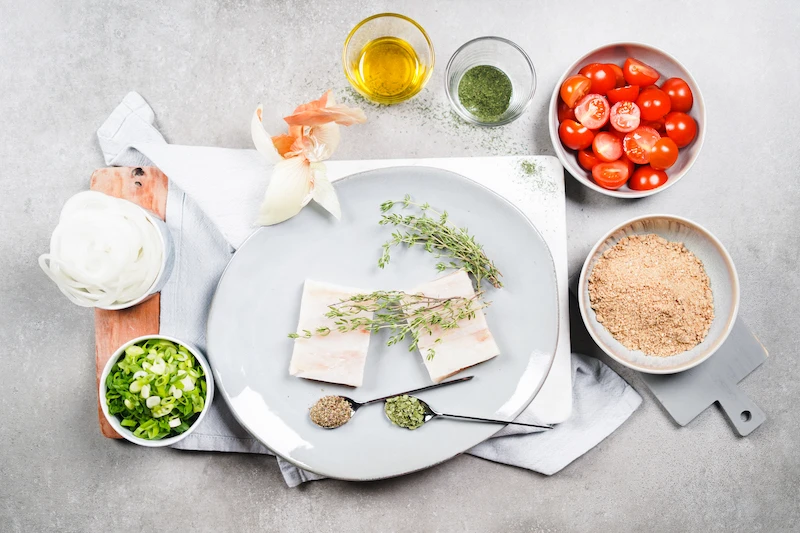
What You’ll Need
This recipe is designed for two people and takes about 40 minutes from start to finish. It’s surprisingly easy to double for a dinner party!
- Cod Fillets: Two 6-ounce (about 170g) center-cut fillets, about 1.5 inches thick.
- Tomatoes: 1 cup of cherry or grape tomatoes, halved.
- Onion: ½ a medium yellow onion, finely chopped.
- Breadcrumbs: ½ cup of panko breadcrumbs is my top pick for ultimate crispiness.
- Herbs: 1 tablespoon of fresh parsley, chopped, and 1 teaspoon of dried oregano. A little lemon zest is also a fantastic addition.
- Oil: You’ll want a high-heat neutral oil (like grapeseed or avocado) for searing, and a good extra-virgin olive oil for the topping.
- Seasoning: Salt and freshly ground black pepper.
Step 1: Get the Right Fish (It Matters More Than You Think)
The success of this dish starts at the store, not the stove. I strongly prefer Atlantic cod for this; it has these big, gorgeous flakes and a slightly sweeter flavor that just works with the acidic tomatoes. Pacific cod is a decent backup, though it’s a bit firmer and milder.
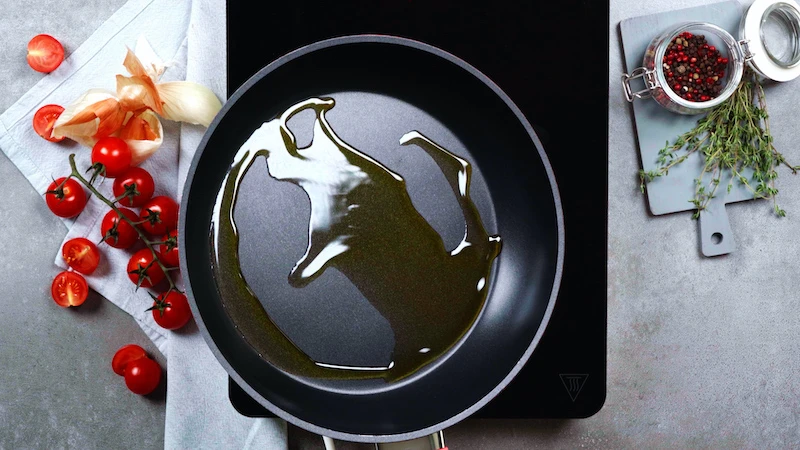
The real secret? Go for a thick, center-cut fillet, sometimes called the loin. These pieces cook much more evenly. Avoid those thin tail pieces, as they’ll be dry before your topping even gets a chance to get golden.
Now for the big question: fresh versus frozen? Honestly, high-quality, flash-frozen-at-sea cod is often better than the “fresh” fish you see at the supermarket counter, which might be days old. Flash-freezing locks in that just-caught texture and flavor. Unless you have a fishmonger you trust completely, top-tier frozen is a super reliable choice. Expect to pay around $18-$25 per pound for quality cod loin; a good frozen option might be closer to the $15 mark.
If you do buy fresh, trust your senses. It should smell clean and briny, like the ocean—not “fishy.” The flesh should be firm and spring back when you press it. If you see any browning or your finger leaves a dent, walk away. For frozen, the key is thawing it right. Move it to the fridge the night before. If you’re in a hurry, you can submerge the sealed package in a bowl of cold water for an hour or two. And here’s the most critical part: once it’s thawed, pat it completely dry with paper towels. A wet fish steams; a dry fish sears. Simple as that.
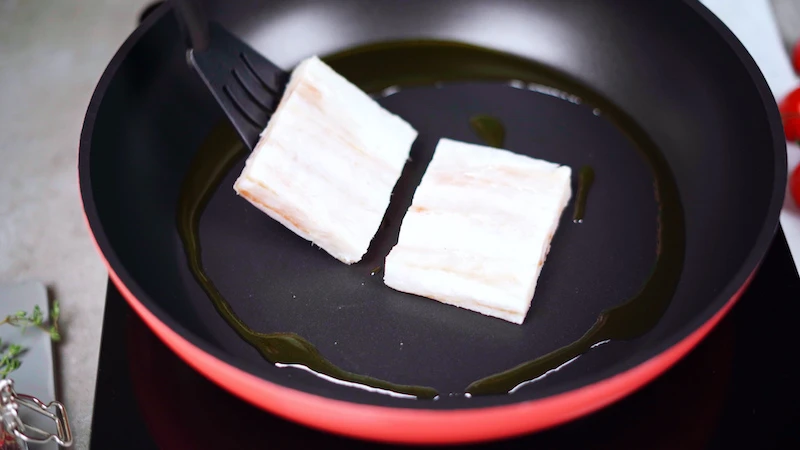
Step 2: The Secret to a Perfect Sear
We start this on the stovetop to build a foundation of flavor that baking alone can’t achieve. This initial sear kicks off the Maillard reaction—that’s the beautiful chemical process that gives browned food its deep, savory taste. It’s why toast is better than bread.
You need a heavy-bottomed pan for this, like a good cast iron or stainless steel skillet. Get it nice and hot over medium-high heat. How hot? A drop of water should sizzle and evaporate almost instantly. Now add a tablespoon of your neutral oil. It should shimmer. Season your dry fillets with salt and pepper, then gently lay them in the hot pan. You want to hear a confident sizzle, not a weak hiss.
Don’t touch it! Let it sear for two minutes to form a crust. You’ll know it’s ready to flip when you can gently shake the pan and the fillet moves a bit without sticking. Give it another minute on the other side, then move the fish to your baking dish. It’ll still be mostly raw inside, which is exactly what we want.
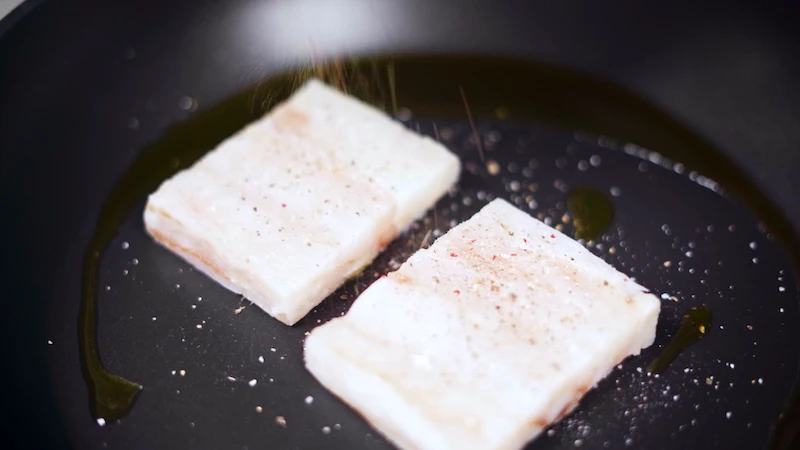
Step 3: Building That Flavorful Tomato Base
Don’t you dare wipe out that pan! Those browned bits left behind—the pros call it the fond—are pure gold. Lower the heat to medium, add a little more oil if needed, and toss in your chopped onions. Cook them gently until they’re soft and translucent, which brings out their natural sweetness.
Next, add the halved cherry tomatoes. They hold their shape while becoming intensely sweet and jammy. Cook for about 5-7 minutes, until they start to break down and release their juices, creating a rustic sauce that will keep the cod moist in the oven.
By the way, this is where you can get creative. Think of the recipe as a starting point:
- For an Italian twist: Add a couple of thinly sliced garlic cloves with the onions. When you add the tomatoes, toss in a tablespoon of drained capers or some chopped Kalamata olives for a briny kick.
- For a Greek vibe: Use a bit more dried oregano. After it’s baked, a generous crumble of good quality feta cheese over the top is perfection.
- For a taste of Spain: Add a half-teaspoon of smoked paprika to the onions. A tiny splash of sherry vinegar with the tomatoes will also brighten everything up beautifully.
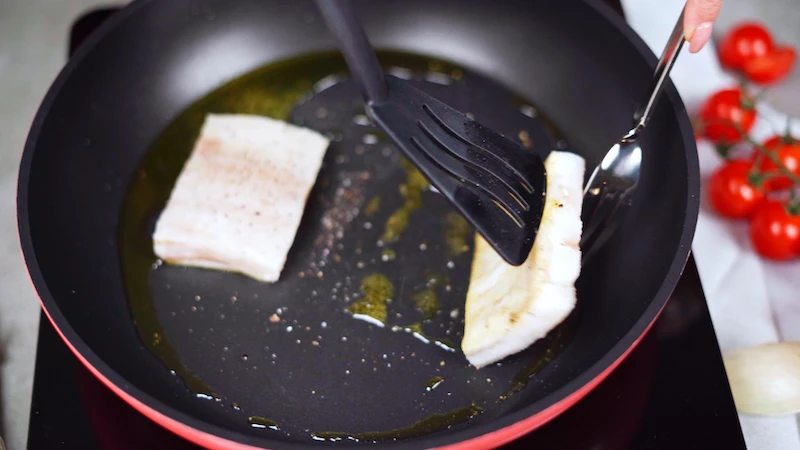
Step 4: The All-Important Crunchy Topping
That crunchy topping is what really makes the dish. The texture contrast is everything. In a separate bowl, mix your panko breadcrumbs with the chopped parsley, oregano, lemon zest, a pinch of salt, and a good drizzle of extra-virgin olive oil. You want the crumbs to be lightly coated, not saturated.
Panko is my go-to because it’s light, airy, and creates the absolute crispiest topping. If you have some day-old bread, you can pulse it in a food processor for homemade crumbs, which are denser but have great flavor. For a gluten-free version, finely chopped almonds mixed with herbs make a fantastic crust.
Quick tip: The breadcrumb topping can be mixed together up to 3 days in advance and stored in an airtight container in the fridge. It’s an instant flavor boost for a busy night!
Step 5: The Final Bake
Time to assemble! Spoon the warm tomato mixture over and around your seared cod fillets. Be generous—this layer is what keeps the fish from drying out. Now, press the breadcrumb mixture firmly onto the top of each fillet.
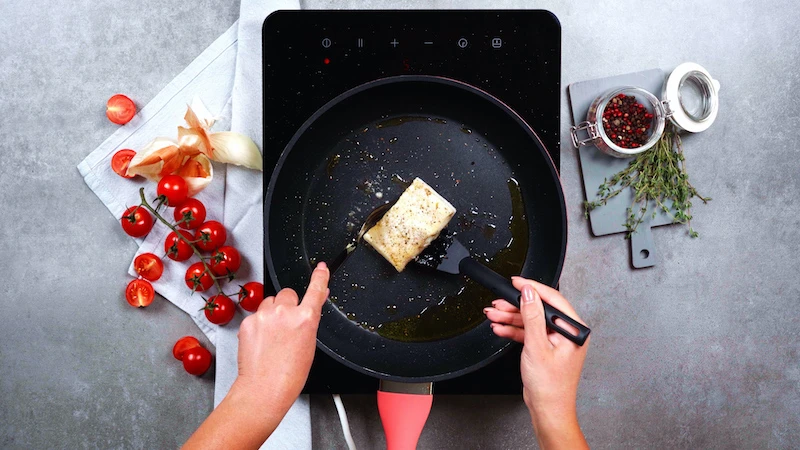
Bake in a preheated 400°F (200°C) oven for 15-20 minutes. But listen, the exact time depends entirely on how thick your fish is. This is where home cooks often go wrong—they just follow the clock.
The single best tool to level up your cooking is a reliable instant-read digital thermometer. Seriously. In my pro kitchen days, we used expensive ones, but honestly, a model like the Kizen or Javelin you can find on Amazon works brilliantly for under $25. Fish is perfectly cooked and safe to eat at 145°F (63°C). But here’s a pro move: I pull my fish out around 135-140°F (57-60°C). It continues to cook from its own heat (that’s called carryover cooking) and will be perfectly flaky and moist by the time you serve it.
Heads up! If the topping is browning too fast, loosely tent the dish with foil. If the fish is done but the topping needs more color, pop it under the broiler for 30-60 seconds. And I mean it when I say watch it like a hawk. I once turned my back for 30 seconds to answer the phone and completely torched a beautiful piece of halibut for a VIP. Don’t be me. NEVER walk away from the broiler.
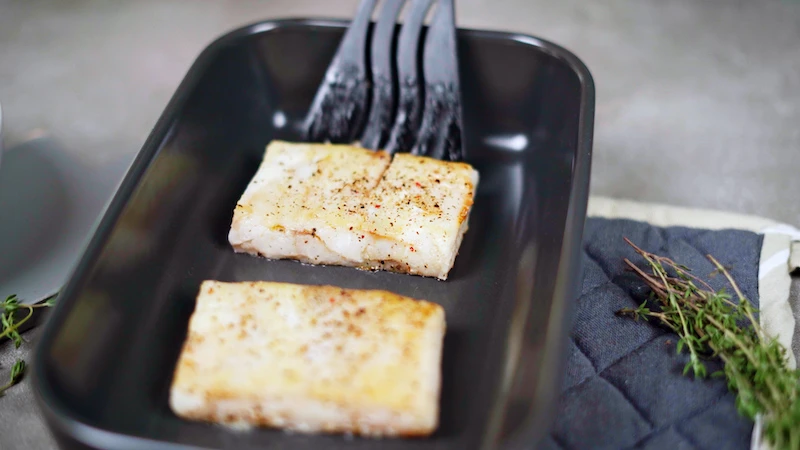
Serving and What to Do With Leftovers
Let the fish rest for a minute or two before serving. This helps the juices redistribute, making it even moister. Use a spatula to lift a fillet and some of the tomato goodness onto a plate. A drizzle of a thick balsamic glaze is a fantastic finishing touch.
This dish is great with fluffy couscous, roasted asparagus, or just some crusty bread for mopping up those incredible juices.
As for leftovers? They’ll keep in the fridge for a couple of days. To be frank, reheated fish is never great—the topping goes soft. My favorite way to use it is to flake the cold cod and tomato mixture into a green salad the next day. It makes for a killer lunch, and you avoid the disappointment of a soggy, reheated meal.
Inspiration:
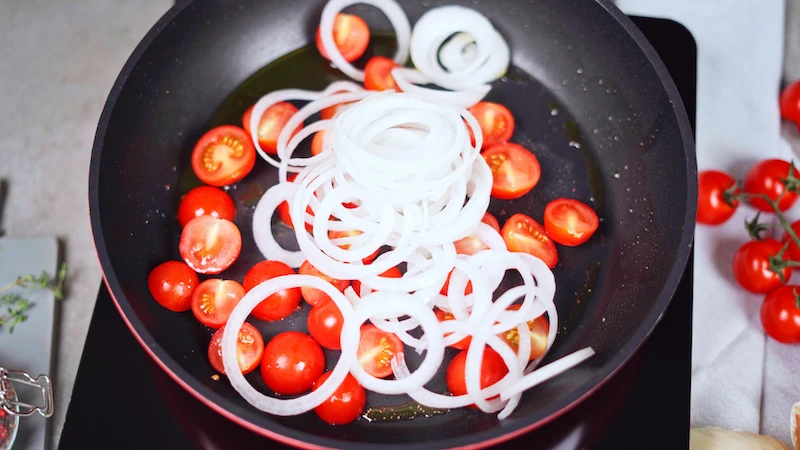
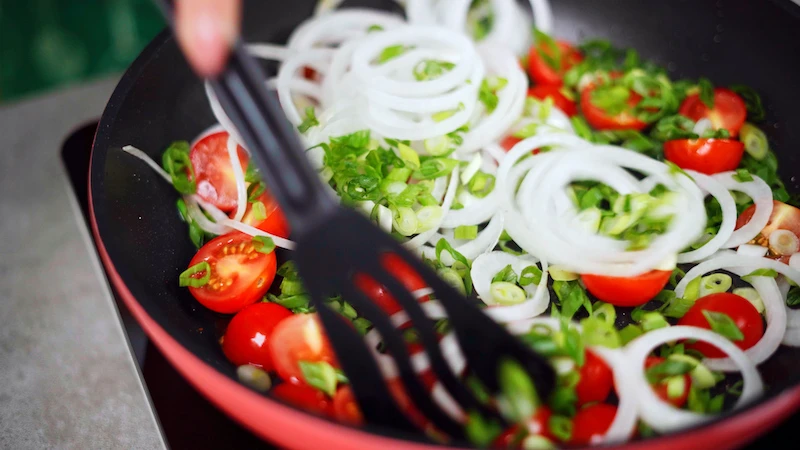
The critical first step: Make sure your cod fillets are bone-dry before they hit the pan. Pat them thoroughly with paper towels. Any surface moisture will steam the fish instead of searing it, preventing that beautiful golden crust the pros achieve. It’s a small detail that makes a world of difference.
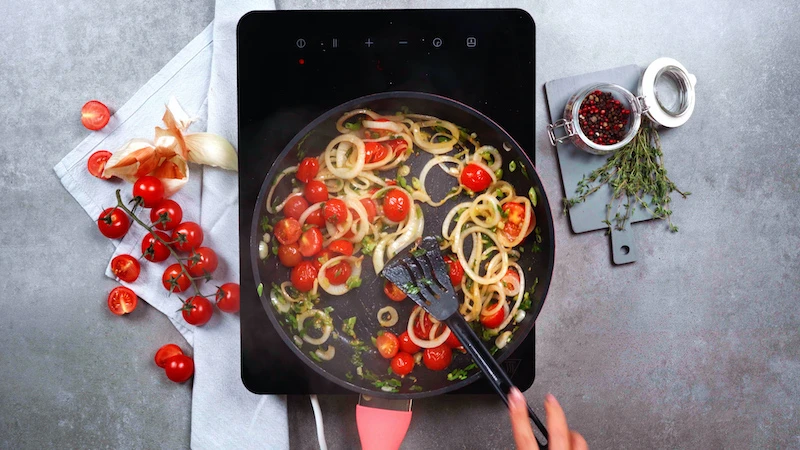
More than 80% of the world’s cod stocks are fully exploited or overexploited.
To ensure this classic dish can be enjoyed for generations, look for the blue MSC (Marine Stewardship Council) label on packaging. This certification guarantees the cod comes from a wild-catch fishery that has been independently assessed for its sustainable practices.
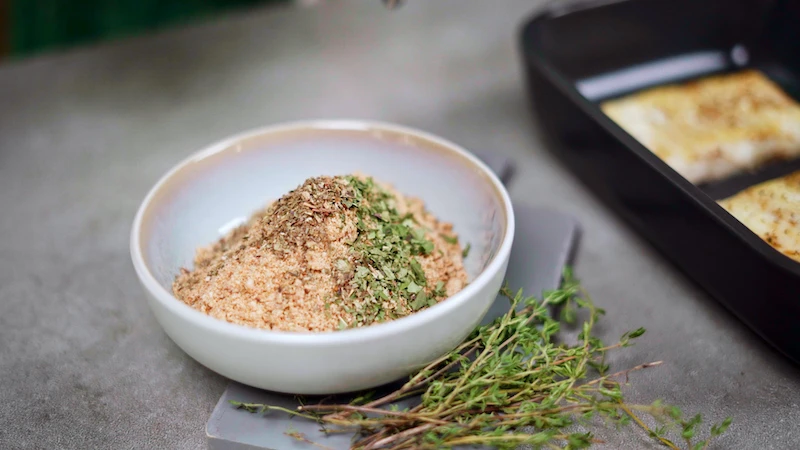
What’s the perfect wine to pour with this dish?
You need a wine with enough acidity to cut through the richness of the oil and complement the tomatoes. A zesty Sauvignon Blanc from the Loire Valley, a crisp Italian Pinot Grigio, or even a dry Provençal Rosé are all stellar choices. They cleanse the palate and let the delicate flavor of the cod shine.
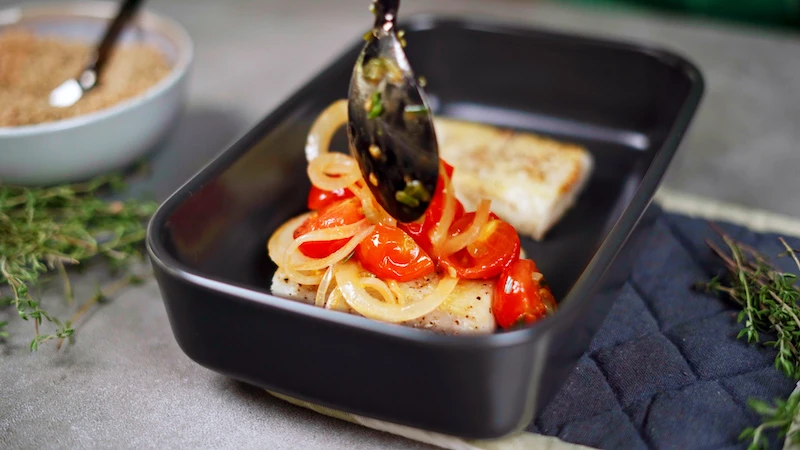
Cast Iron Skillet: Delivers unbeatable heat retention for a deep, even sear. A well-seasoned pan from a brand like Lodge is a kitchen workhorse and perfect for this job.
Stainless Steel Pan: Heats up faster and is more responsive to temperature changes, giving you precise control. An All-Clad or Cuisinart stainless pan allows you to build a beautiful ‘fond’ (the browned bits) with the onions and tomatoes.
Both are excellent choices; it’s a matter of classic ruggedness versus nimble precision.
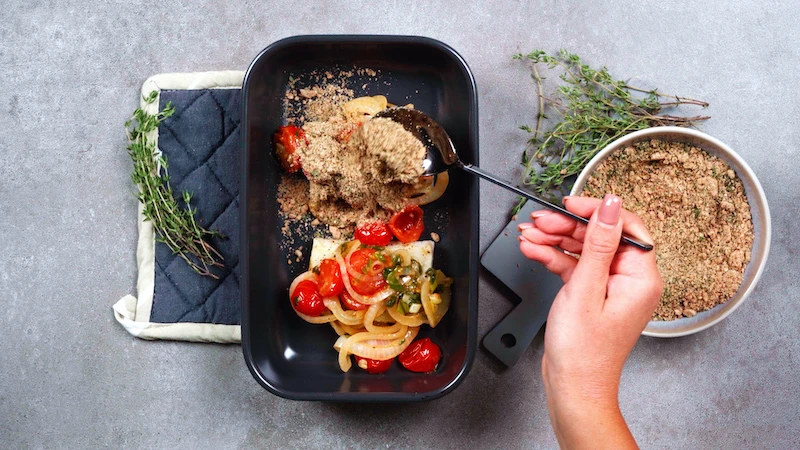
Take the crunchy topping to the next level by customizing the flavor. Think beyond the recipe’s suggestions and create a signature blend.
- Mediterranean Vibe: Add finely chopped Kalamata olives and a pinch of lemon zest.
- A Bit of Heat: Mix in a dash of red pepper flakes or a sprinkle of smoked paprika.
- Fresh & Aniseed: Swap the parsley for fresh dill or tarragon for a completely different aromatic profile.
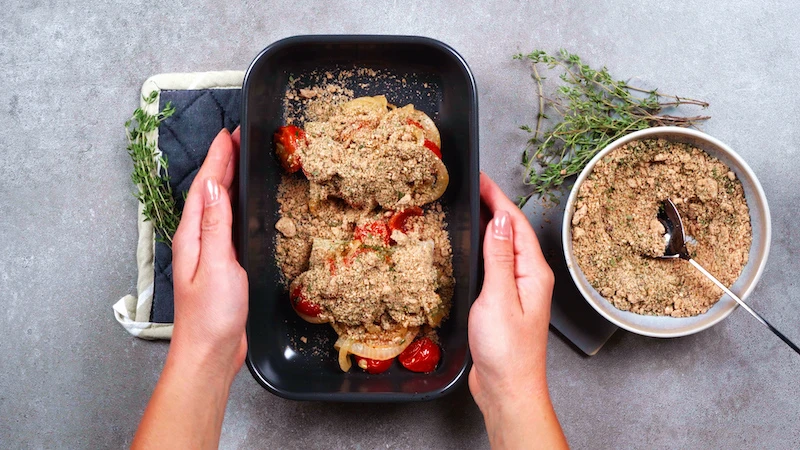
The magic of this dish lies in its textural symphony. It’s the satisfyingly loud crunch of the panko giving way to the impossibly tender, flaky cod that separates from the fork in pristine layers. Then, the sweet, jammy burst of a roasted tomato cuts through it all. It’s a dish that engages all the senses, evoking the feeling of a sun-drenched meal by the sea.
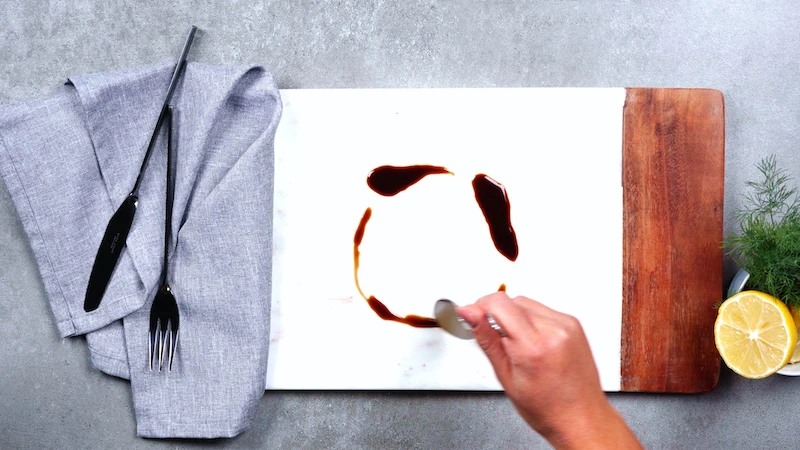
- A vibrant, professional-looking plate.
- An extra layer of fresh, peppery flavor.
- A beautiful contrast in color and texture.
The secret? A simple finishing touch. Once plated, drizzle with a high-quality finishing olive oil—something grassy and robust like a California Olive Ranch Reserve—and scatter a few micro-arugula or basil shoots on top. It’s an effortless move that screams ‘special occasion’.
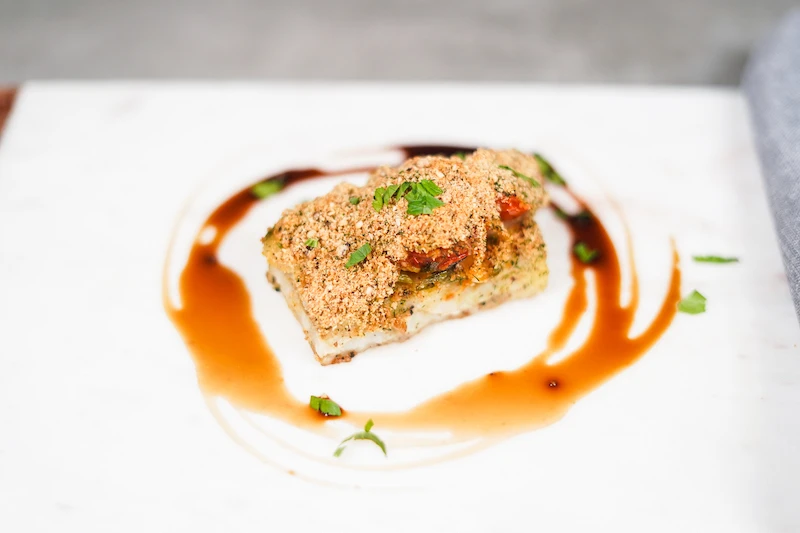
The ideal internal temperature for perfectly cooked, moist cod is 140-145°F (60-63°C).
Remember that the fish will continue to cook from residual heat after you pull it from the oven—a process called carryover cooking. For best results, use an instant-read thermometer like a Thermapen and remove the pan when the thickest part of the fillet reads 135°F (57°C). Let it rest for a few minutes to reach perfection.

Can’t find good cod or want to try something different? This recipe is wonderfully versatile. Look for other firm, flaky white fish fillets of a similar thickness.
- Haddock: Slightly sweeter and more tender than cod.
- Pollock: A more budget-friendly option with a milder flavor.
- Halibut: A meatier, firmer texture for a more steak-like experience.
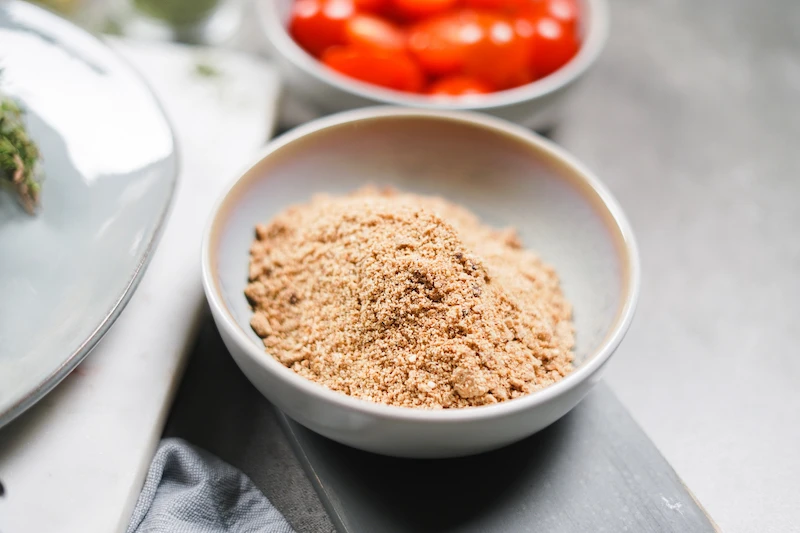
This style of preparation, known in Italy as ‘al forno con pomodorini,’ is a testament to the country’s cooking philosophy: source the best ingredients and do as little as possible to them. From the Amalfi Coast to Sicily, you’ll find variations of fish baked with cherry tomatoes, garlic, oregano, and breadcrumbs, a timeless combination that celebrates simplicity and freshness.
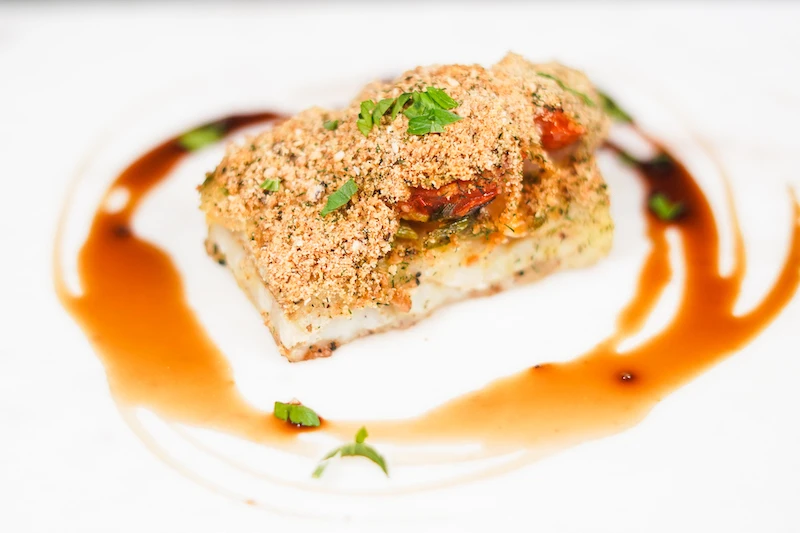
Panko is out? Don’t panic, just pivot.
While panko offers the lightest, crispiest texture, you have other great options in your pantry. For a rustic, hearty crunch, pulse a slice of stale sourdough or ciabatta in a food processor. In a real pinch, crushed saltine crackers or even cornflakes (unsweetened, of course!) can provide that necessary crunchy topping, each bringing its own unique texture and flavor to the dish.
A word on the balsamic: The gallery shows a drizzle of balsamic, which can be a delicious, tangy counterpoint. However, be careful. Using a thin, acidic balsamic vinegar can overpower the delicate fish. Instead, opt for a thick, syrupy ‘balsamic glaze’ or, even better, make your own by gently simmering a good quality balsamic from Modena until it reduces by half. Use it sparingly for a touch of sweet acidity.










